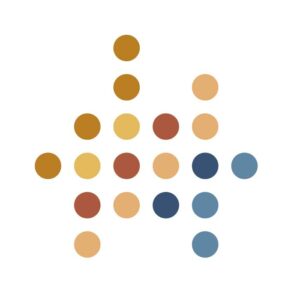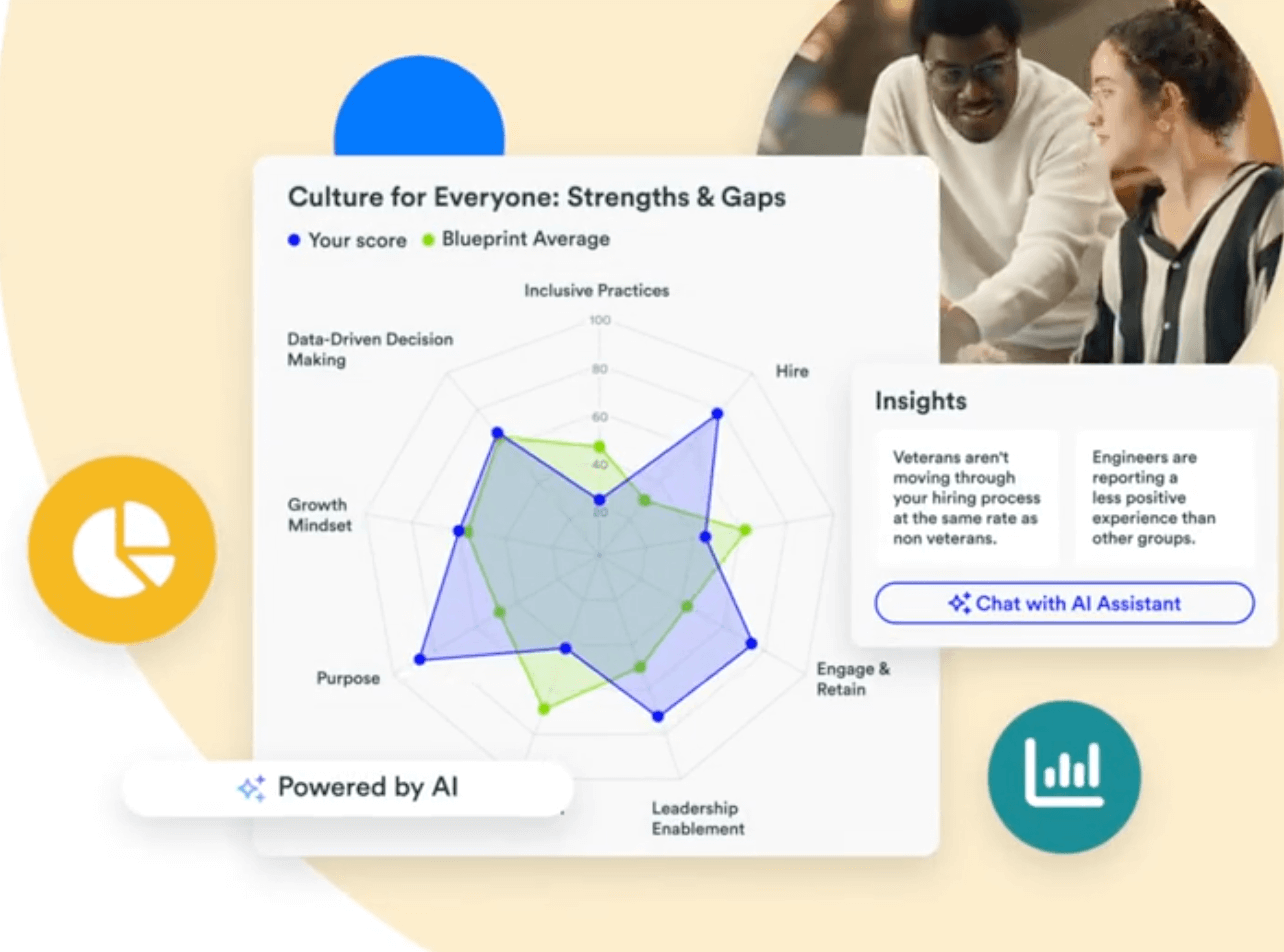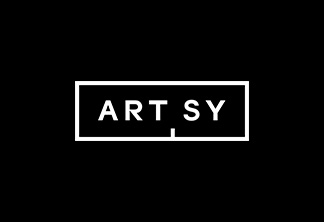A high-performance culture doesn’t happen by accident; it’s the result of purposeful, data-driven decisions. But creating that kind of culture requires more than just good intentions.
When cultural promises aren’t backed by action, people notice. And when employees don’t feel supported or valued, their sense of belonging suffers, which can quietly erode culture, productivity, and retention.
Change starts with leaders who are willing to examine how their behaviors and systems impact fairness, trust, and belonging. By adopting organizational leadership principles and equipping your leaders with the systems that reinforce inclusion, you can foster a culture where everyone thrives. Companies that excel in this area outperform the market by 16.5%.
Learn how to bridge the belonging gap and integrate inclusion into everyday decisions. You can cultivate a high-performance culture where employees feel they belong, perform at their best, and stay longer.
What Is a High-Performance Culture?
A high-performance culture aligns teams around shared goals, maximizes individual strengths, and encourages every employee to contribute. It focuses on inclusivity, accountability, feedback, and empowerment to help team members feel fulfilled and confident in their roles.
Empowering team members to create a high-performing workplace requires the following organizational leadership practices:
- Establish clear accountability: Develop and document expectations, implementing communication and management channels to maintain standards.
- Facilitate inclusion and equity: Attract and support diverse talent whose unique perspectives and experiences add value.
- Create open communication: Build an environment where everyone can speak up and contribute meaningfully to foster a sense of belonging and increase employee engagement.
- Implement continuous learning and growth: Establish effective feedback loops and provide teams with the tools to collaborate with coworkers from diverse backgrounds.
These inclusive HR leadership steps foster an environment that promotes growth and enhanced performance. Paradigm’s 2025 Benchmarking Study shows that organizations are increasingly prioritizing this work, with 85% of organizations reporting that leadership is as or more committed to building inclusive cultures than a year ago.
8 Steps for Building a High-Performance Culture
While 89% of leaders believe they are rational and objective at work, only 38% regularly use tools that reduce bias, such as role-level expectations, checklists, and software. Here’s how to implement a productive work environment with systems and strategies that equip your leaders and allow all team members to thrive.
1. Empower Leaders to Champion Inclusivity
Leaders set the tone. Start with modeling an inclusive culture right from the beginning of the recruitment process. Inclusive leadership drives innovation and performance by empowering teams to do their best work.
Hannah Yardley, a chief people and culture officer, explains the importance of embedding culture across all stages of the employee experience:
“Because we know that culture is so important, each employee needs to witness what we highlighted in the recruitment process within the early days of their onboarding experience.”
Yardley recommends consistently reinforcing organizational values with employees at each step in the journey.
Paradigm’s Inclusive Leadership framework supports this process through its four key pillars:
- Objectivity: Make consistent, equitable decisions.
- Belonging: Create space for team members to show up authentically.
- Voice: Ensure everyone feels heard and valued.
- Growth: Encourage continuous learning and development.
Help your leaders establish this framework through training, such as Paradigm’s tailored workshops or online courses focused on developing inclusive management skills.
2. Ensure Fair Access to Information
After empowering your leaders, the next step is to ensure that information flows freely—transparency builds trust. A high-performance organization requires systems where all employees can access the information they need to succeed.
Start by:
- Auditing communication: Uncover information bottlenecks or silos within teams.
- Unifying resources: Build a shared hub that’s easy to navigate and provides space for features like forums or comments.
- Providing training: Equip leaders to share and engage with employees from all backgrounds.
Standardizing communication and collaboration tools reinforces clarity and reduces alignment issues that otherwise inhibit fair informational access.
3. Encourage and Facilitate Collaboration
According to Paradigm research, when companies build a culture for everyone, they see 56% higher job performance. That kind of inclusive culture thrives on collaboration, which drives productivity. High-performance teams prioritize creating deliberate opportunities for employees to connect across roles and functions.
Facilitate collaboration with:
- Team-building exercises: Implement planning and brainstorming sessions, schedule retreats and conferences, or rotate team members across projects to create new connections.
- Praise and encouragement: Recognize and highlight team successes, even with something as simple as a LinkedIn shoutout. Small gestures go a long way.
- Shared ownership: Position your organization’s culture so everyone can contribute and feel a sense of team agency.
- Collaboration tools: Use software like Slack for team chat, AirTable for project management, and Loom for recorded videos to increase clarity and communication.
4. Promote Ongoing Feedback and Growth
Healthy collaboration thrives in a feedback-rich workplace culture, which fuels business growth. Team members perform better when leaders offer frequent, actionable input that supports continuous learning. According to Gallup, 61% of employees who receive feedback and recognition from their manager at least once a week are engaged in the workplace.

Paradigm Reach, for example, facilitates feedback initiatives using multi-part training and micro-learning sessions on topics like inclusive high-performance management to help ensure fair feedback and support for all employees.
Other ways your leaders can provide consistent feedback include:
- Conducting one-on-one meetings: Hold regular meetings or check-ins between supervisors and employees to provide tailored feedback.
- Encouraging a growth perspective: Train managers to see challenges as learning opportunities. Championing a growth perspective gives team members ample space to overcome challenges.
5. Strengthen Psychological Safety Across Teams
Psychological safety is the foundation of high-performance teams. When team members feel safe taking risks, sharing ideas, and speaking up without fearing negative consequences, they contribute more freely and creatively.
Higher-performing employees innovate and improve faster and more often. A study by Frontiers in Psychology found that personal perception of inclusive leadership enhances psychological safety, which drives team member performance and innovation. Paradigm’s research with 38,000 employees found that those who feel a strong sense of belonging are 10x more likely to be engaged at work.
To build psychological safety:
- Conduct leadership team training: Help managers become more vulnerable, model inclusivity, and normalize learning from mistakes.
- Encourage “fail fast” ideals: Treat experimentation as essential, not risky.
6. Standardize Performance Management Systems
Fair and consistent reviews help team members grow and stay engaged. Without clear expectations and unbiased performance management systems, even the most driven employees may feel overlooked.
Your leaders can standardize performance by:
- Defining benchmarks: Link performance to business goals to ensure contributions are clear and measurable.
- Introducing peer feedback: Encourage team members to provide their thoughts for a broader perspective.
- Auditing your process: Review promotions, pay, and hiring trends to spot disparities and close gaps.
If you discover unfair practices across a demographic group, analyzing your systems—from job descriptions and interviewing practices to long-term performance expectation management—will help you address root causes.
7. Align Incentives and Recognize Achievement
Company core values shape how you reward performance. High-performing cultures recognize behaviors that support collaboration, inclusion, and innovation.
Make recognition meaningful with:
- Public praise: Share big wins tied to corporate culture.
- Incentives: Offer perks or bonuses for achieving collaborative goals.
- Strategic reviews: Distribute rewards fairly to ensure their impact.
Aligning performance with purpose helps reinforce what your company values most.
8. Prioritize a Holistic Employee Experience
Sustained high performance comes from more than productivity tools and clear goals. It requires a workplace that supports the whole person. When employees feel valued—not just for what they do but for who they are—they’re more likely to engage, stay, and thrive.
A holistic approach to the employee experience acknowledges individual needs, personal identities, and cultural backgrounds. It means investing in inclusive policies that support work-life balance, mental health, and cultural programs.
To support more holistic experiences:
- Offer support: Invest in mental and physical health programs (like a mindfulness app or fitness stipend), allow flexible schedules, and increase access to assistance programs.
- Create community: Facilitate diverse groups and mentorships so all employees receive the culturally relevant support they need.
- Develop feedback systems: Measure progress by sending surveys and conducting employee interviews.
- Celebrate cultural events: Celebrate relevant, diverse holidays and provide space for your team to connect and share their backgrounds.
Why Building a High-Performance Culture Matters
What happens when workplace culture breaks down? Trust erodes. Employees disengage. Productivity and retention take a hit. This has become a growing issue—in the US alone, employee engagement hit a 10-year low in 2024, with only 31% of employees engaged.
Like building a home, you need a solid foundation to support progress, and workplace culture is that foundation. High-performing cultures aren’t powered by lofty ideals, they’re rooted in everyday behaviors that drive measurable business outcomes.
McKinsey reports that organizations in the top percentile of employee engagement are 23% more profitable than those in the bottom percentile. If you want to improve sales, innovation, or customer satisfaction, it starts with your people.
In today’s workforce—with more racial, generational, and neurodiverse talent than ever before—your culture change needs to be designed for everyone. Brands with healthy cultures experience lower turnover, improved retention, and greater alignment with business objectives. When your employees can freely innovate and collaborate as valued team members, high performance becomes not only possible but sustainable.
Frequently Asked Questions About High-Performance Culture
Below are some common questions Paradigm hears from companies working to reshape their culture to attract top talent and improve performance.
Can high performance exist without formalized processes?
In small or close-knit teams, a shared purpose and trust might temporarily drive performance. But without a formal process, teams often lack the diverse perspectives needed to innovate, scale, and solve complex problems.
A high-performance company culture needs intentional processes and systems, including tools that provide a unified view of workplace data and resources that support inclusive, consistent performance at every level.
How do you measure success in a high-performance culture?
Human resource leaders must examine people and business metrics to define success. Key indicators include employee Net Promoter Scores (eNPS), turnover rates, internal promotion rates, and customer satisfaction scores. You also want to evaluate whether all your team members feel valued and have equal opportunities to share and contribute.
How can you assess if your work culture is helping or hurting performance?
Assessing workplace culture involves both qualitative and quantitative assessments. Surveys and interviews reveal how employees experience your culture, such as whether underrepresented team members have the same access to challenging projects or if high-performing contributors often feel overlooked.
Connecting culture performance indicators (CPIs) to key performance indicators (KPIs) addresses both qualitative and quantitative needs. For example:
- CPI: Interviews reveal low team trust.
- KPI: You find you’re not meeting sales goals. When you dig deeper, you see that the team members who report the most distrust are also underperforming.
- Approach: To improve sales, invest in inclusivity training for managers that fosters trust, collaboration, and a psychologically safe, innovative culture.
When you connect employee experience data to business outcomes, you uncover the “why” behind your metrics and gain the clarity needed to drive meaningful change.
Build Inclusive, High-Performing Teams With Paradigm
High-performance cultures are inclusive, intentional, and aligned with business goals. When you build your culture based on data-driven actions, you create a workplace where every team member can thrive.
Paradigm provides the tools and expert support to create a stronger culture of belonging that fuels performance. AI-powered insights and tailored guidance highlight culture gaps and support real, continuous improvements. Blueprint analytics reveal how teams experience inclusivity and belonging, pinpointing where to adjust your strategy to improve outcomes.
Contact us to uncover key insights, track progress, and leverage data to cultivate a culture that amplifies your business impact and drives profitability.

 Our website uses cookies to distinguish you from other users of our website. This helps us to provide you with a good experience when you browse our website and also allows us to
improve our site. By continuing to browse our website, you’re agreeing to our use of cookies. For more information, please read our
Our website uses cookies to distinguish you from other users of our website. This helps us to provide you with a good experience when you browse our website and also allows us to
improve our site. By continuing to browse our website, you’re agreeing to our use of cookies. For more information, please read our







